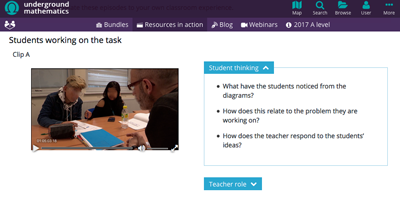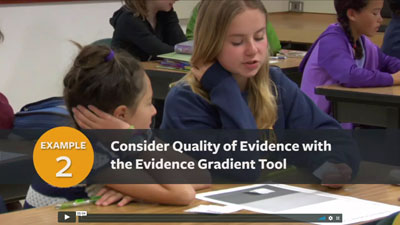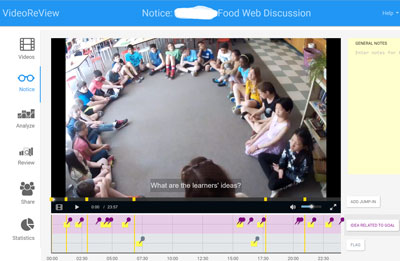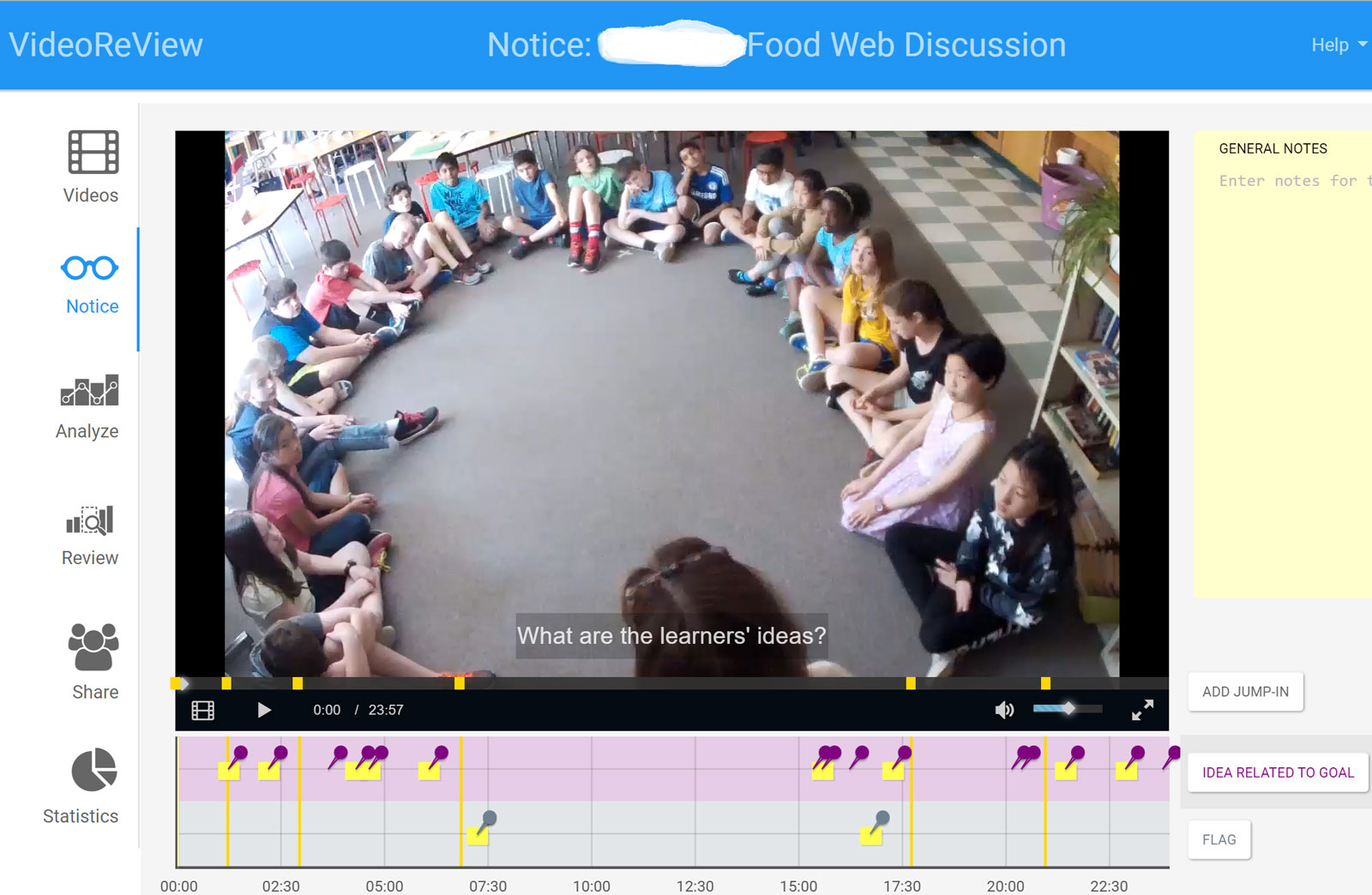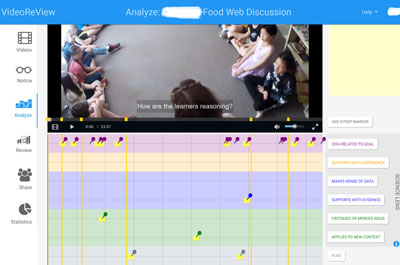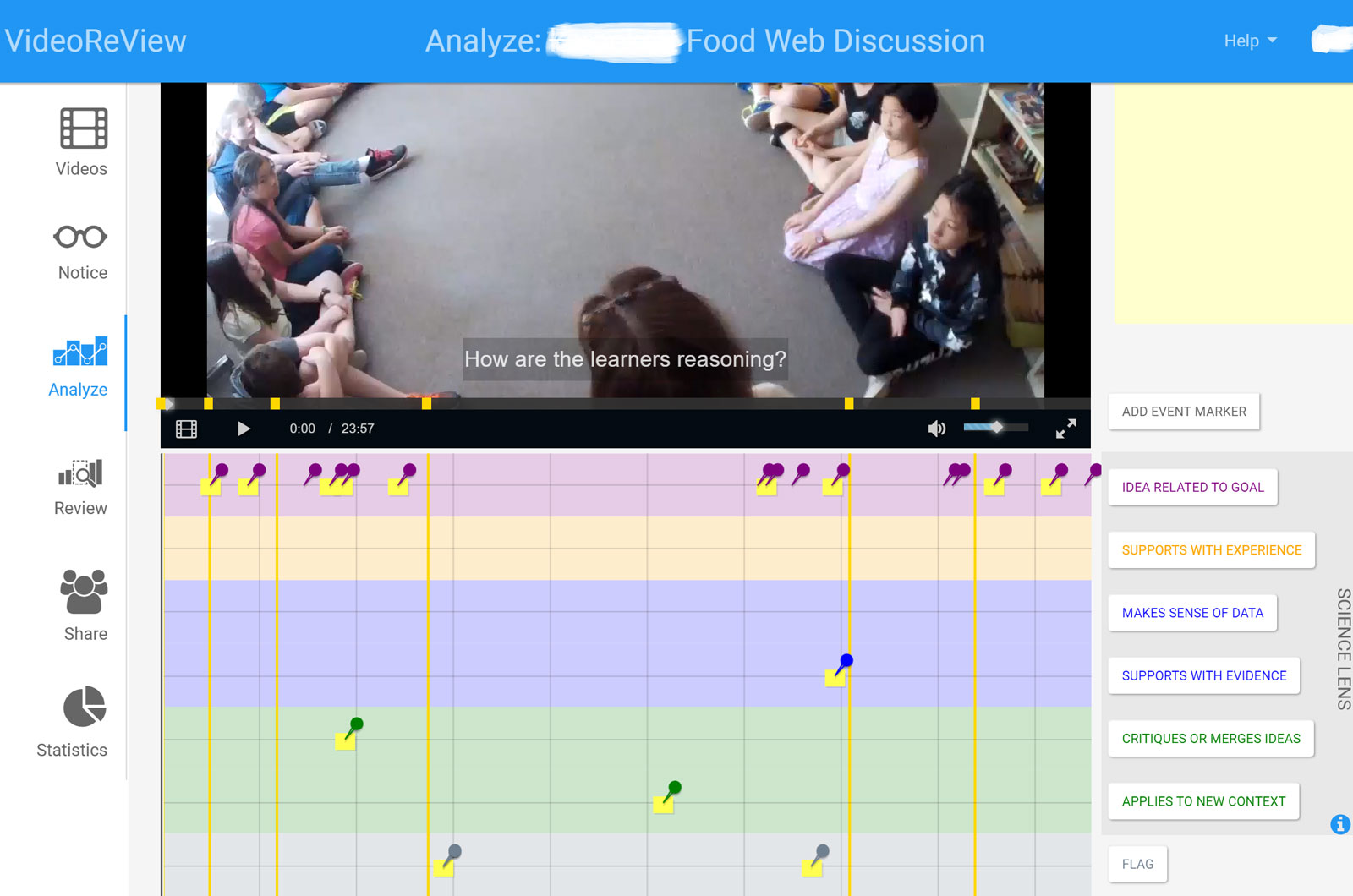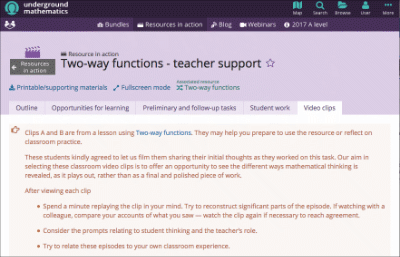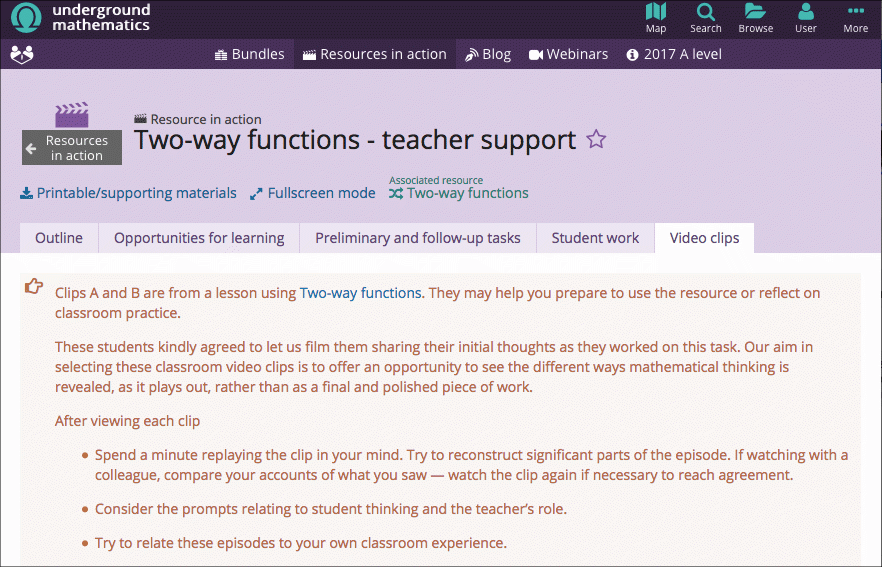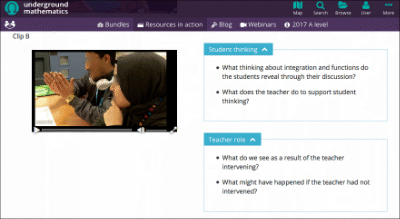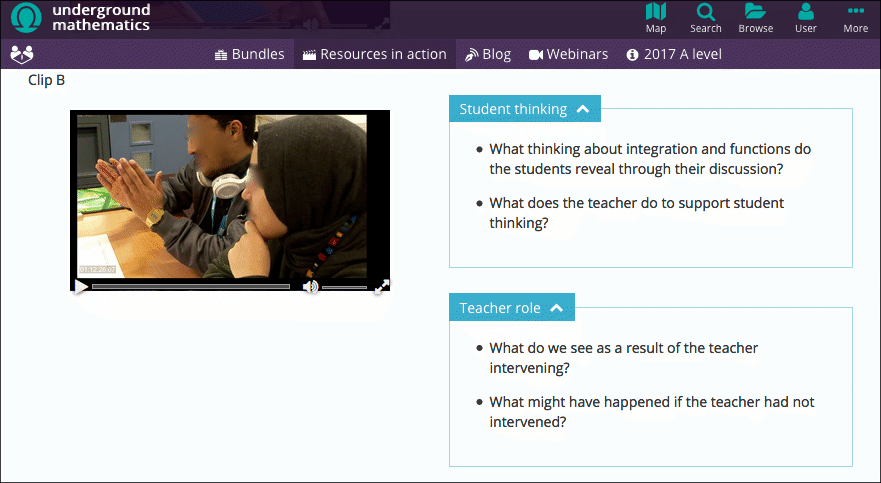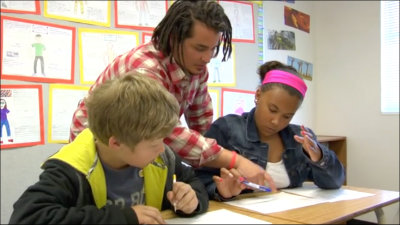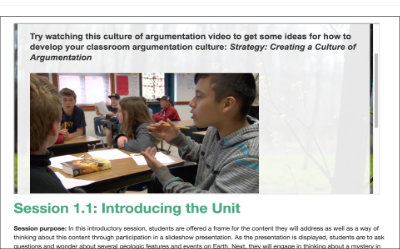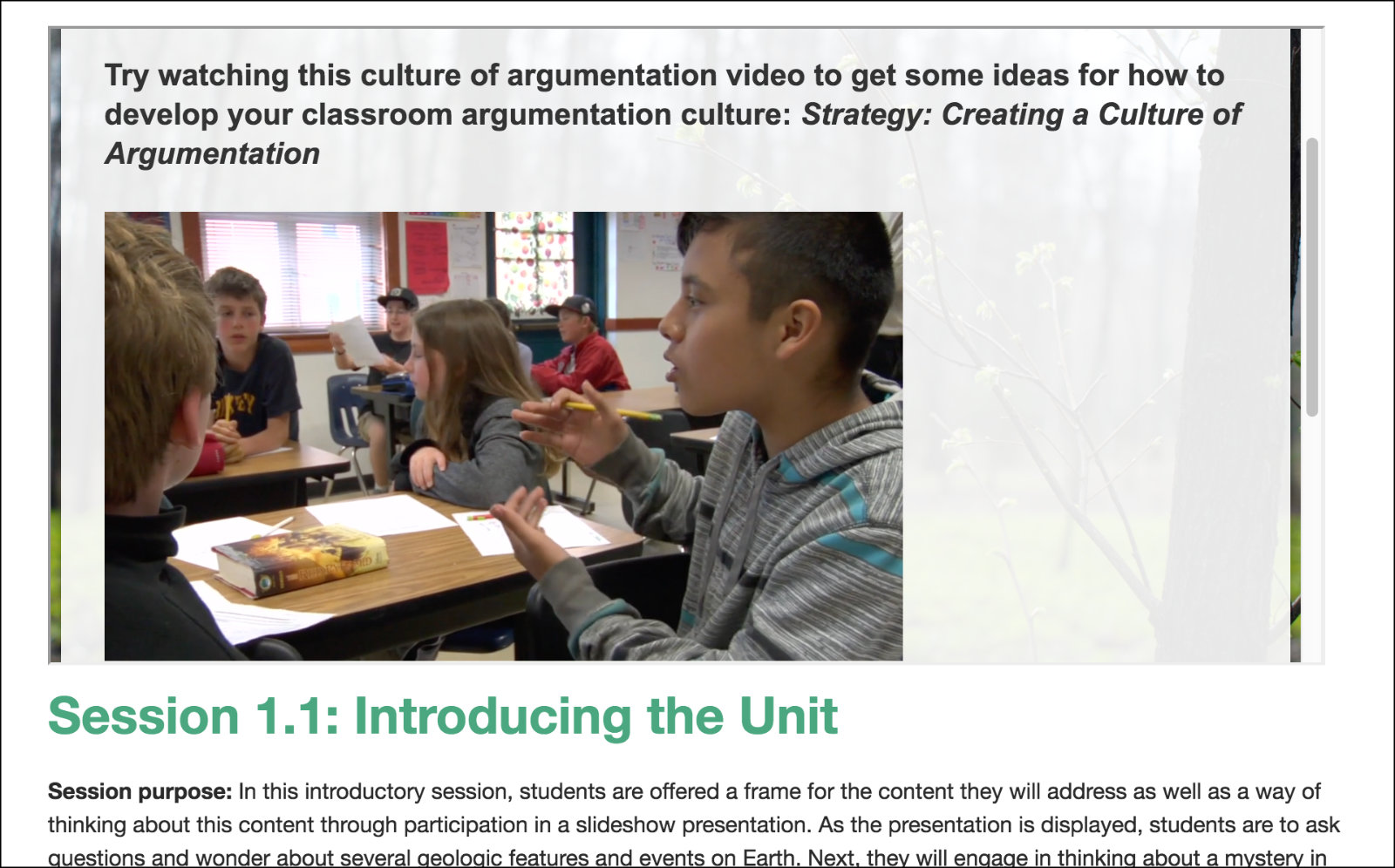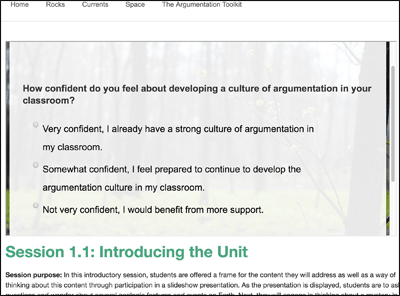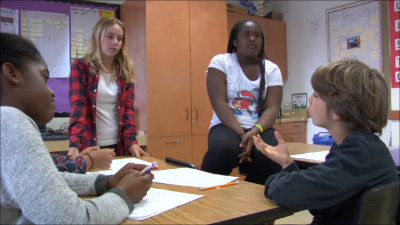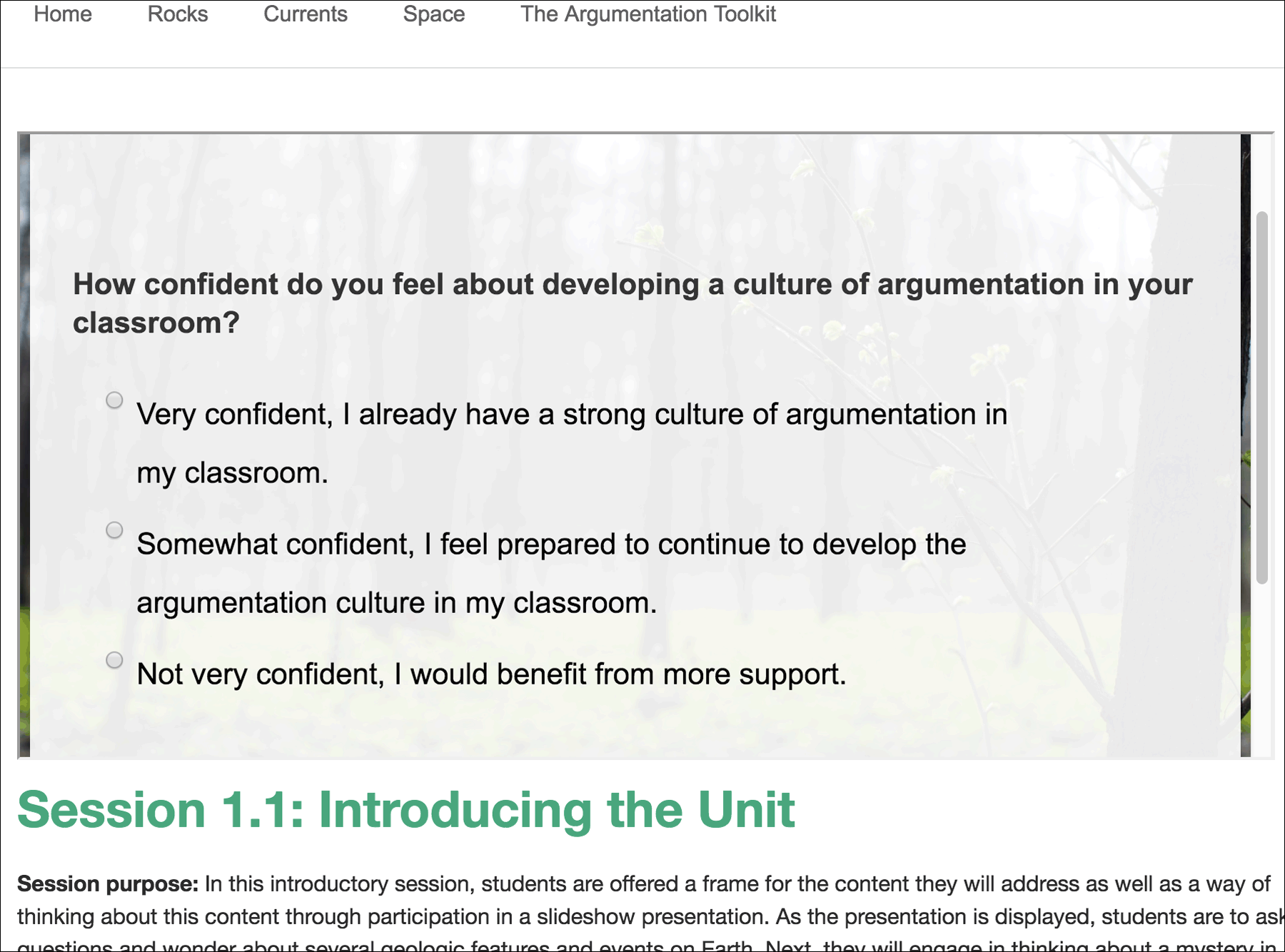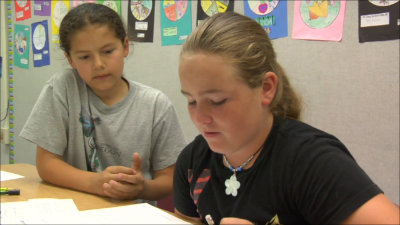The video clips in the UM and MECM projects also depict students’ thinking as they engage in small groups or whole class discussions. In the UM project, videos capture students’ unscripted attempts at solving rich instructional tasks in mathematics, showing them working through initial confusions and different approaches. For example, the first video clip on this page (Figure 1) shows a student struggling to formalize the relation between areas bounded by exponential and logarithmic graphs.

Three Design Heuristics for Enhancing the Use of Video to Improve Teaching Practice
Anushree Bopardikar (TERC, USA),
Janet Carlson (Stanford University, USA),
Elizabeth Kimber (University of Cambridge, UK),
Suzanna Loper (University of California Berkeley, USA),
Natalie Pareja Roblin (University of Pittsburg, USA),
Tatiana Rostovtseva (University of Cambridge,UK)
Abstract
iThe use of video tools to support teacher learning has become increasingly widespread. While evidence points to the multiple affordances of video to enhance teacher learning, specific design principles that can guide the use of current video-based tools have not been well articulated. With the ultimate goal of developing a framework with shared design heuristics for the use of video to improve teaching practice, this paper describes the design strategies used by four research and development projects concerned with the use of video to support teacher learning in STEM subjects. Based on a review of the literature and inductive analyses of common design features across the four projects, three key design heuristics were identified. We describe the three heuristics including both a discussion of relevant literature and detailed examples of how the heuristics were implemented across the four projects. Altogether, the three design heuristics illustrate various ways to use video as a tool for teacher learning and yield insights that can inform the design of future video-based professional learning experiences.
Introduction
iiVideo has become an increasingly popular tool for teacher learning around the world. Watching and reflecting on videos of classroom practice, whether their own or a colleague’s, provides teachers with valuable opportunities for growth.
Research suggests that video can contribute to teacher learning in multiple ways. First, video situates teacher learning within the context of teachers’ daily work by providing concrete examples that capture the richness and complexity of classroom practice (van Es, Tunney, Goldsmith, & Seago, 2014; Zhang, Lundeberg, Koehler, & Eberhardt, 2011), and by making those practices available for rigorous inquiry and analysis (Roth et al., 2015). Second, video contributes to teachers’ ability to notice classroom interactions by allowing them to “slow down” teaching and learning processes and focus on the analysis of student thinking (Barnhart & van Es, 2015; Sherin & van Es, 2005). In fact, several studies have found that the systematic analysis and discussion of video can contribute to change both what teachers notice (e.g., shifting their focus from classroom management issues to students’ understanding) and how they interpret these events (e.g., moving from evaluative to interpretative comments), ultimately leading teachers to change their instructional practices (Mitchell & Marin, 2015; Sherin & van Es, 2005; van Es & Sherin, 2010). Third and last, by allowing teachers to re-view classroom episodes multiple times and from different perspectives, video offers many opportunities to support teacher reflection and to inform subsequent pedagogical decisions (Tripp & Rich, 2012; van Es et al., 2014).
While vast evidence exists for the affordances of video to foster teacher learning, best practices for designing and implementing video-based professional development have not yet been well articulated. In the current paper we present the results of a collaboration aimed at developing a framework with shared design heuristics for the use of video as a professional development tool. The collaboration was initiated at the 2015 ISDDE annual conference, and involved researchers from three countries working in four research and development projects that are each concerned with the design of video and related supports to facilitate teacher learning in STEM subjects. Together, the projects illustrate diverse uses of video to support teacher learning, including teachers’ own videos used in the context of professional development programs (VideoReView and Hollyhock Fellowship Program), as well as videos of other teachers’ practice embedded in educative curriculum materials (Underground Mathematics and Multimedia Educative Curriculum Materials). The projects are summarised below.
Based on a review of the literature and inductive analyses of common features across these four projects, three key design heuristics were identified:
- Design Heuristic 1: Video should be situated in the daily practice of classroom teaching.
- Design Heuristic 2: Video use and supports should facilitate teachers’ ability to notice students’ thinking and classroom interactions.
- Design Heuristic 3: Video use and supports should encourage teachers to reflect on their own teaching, connect student thinking and teachers’ actions, and inform pedagogical decisions.
After describing the projects, we elaborate each of these three design heuristics, including both a discussion of relevant literature and detailed examples of how the heuristics were implemented across the four projects. Altogether, the analysis and discussion of the three key design heuristics yield insights that can inform the design of video-based professional learning experiences and add to the extant research about how specific features of video and related supports might promote teacher learning.
Project Descriptions
iiiTeachers’ own video within a professional development program
The project Empowering Teachers Through VideoReView (VRV) is a video-supported professional development (PD) program in which teachers capture and study video of their own classrooms to examine students’ science ideas and reasoning. Teachers also share and discuss video cases with colleagues in school-based, teacher-led ‘Video Clubs’. Supporting the PD is a classroom-friendly hardware and software tool to help teachers capture and analyze video on an ongoing basis, thus providing them with timely feedback on their students’ learning. The goal of the program is to develop teachers’ abilities to notice their students’ science ideas and reasoning, and to respond based on students’ science understandings. Additionally, the VRV program provides teachers with written supports to plan, enact and videotape whole class science discussions; study videos of their discussions; prepare video cases; and participate in and lead Video Club meetings with colleagues.
The Hollyhock Fellowship Program (HFP) is a two-year arc of professional learning experiences and collaboration, combining intensive face-to-face professional development experiences in the summer with video-based coaching sessions during the school year. The fellows are early-career high school teachers who apply to the program in teams of three or more. The goals of the program include the following:
- improving instruction by supporting teachers in the use of a carefully selected set of core practices while developing their role as instructional decision-makers,
- strengthening pedagogical content knowledge and deepening disciplinary content knowledge,
- developing instructional leaders who create equitable learning opportunities for all students, and
- building professional community at multiple levels.
The video-based, virtual coaching aspect of HFP provides strategic and differentiated support for fellows. The goal is to support each fellow in the classroom, at the school, and within the profession. At a practical level, the platform includes a smartphone app for recording with direct upload to the cloud. The coach is the primary source of support for reflecting on and considering pedagogical decisions.
Video of other teachers’ practice within educative curriculum materials
2Underground Mathematics (UM) provides rich classroom tasks online for teaching Advanced level (A level) mathematics in the UK and beyond. UM is primarily a curriculum project, but in response to teacher feedback UM developed a number of online materials to support teachers’ PD. For a small collection of tasks, this included video of students working on the tasks, as well as student and teacher reflections. It was envisaged that the videos would primarily support teachers working individually online, but they have also been used in face-to-face UM-PD and by other organizations offering online PD for A level mathematics.
The Multimedia Educative Curriculum Materials (MECM) project is a research and development project, which created multimedia educative curriculum materials to support middle school teachers in learning to teach about scientific argumentation. The MECMs included short teacher-facing videos about argumentation, which were embedded in a web-based teacher’s guide for three Earth and Space Science teaching units. The project investigated teachers’ use of these videos and their impact on teachers’ beliefs and pedagogical content knowledge. Although the videos were originally designed to be embedded within curriculum, they are also shared on argumentationtoolkit.org, and there are teacher learning modules to support their use in teacher professional learning.
Heuristic 1
ivOur first heuristic is focused on establishing a close connection between video use and teachers’ daily practice. In this section, we briefly summarize literature related to this heuristic, describe two main ways this heuristic can be implemented, and illustrate these approaches with examples from each of the four projects.
This heuristic draws on the notion of situated cognition, which suggests that knowledge is inseparable from the contexts and activities in which it is developed (Brown, Collins, & Duguid, 1989). A situative perspective on cognition acknowledges that knowing and learning are 1) situated in physical and social contexts, 2) social in nature, and 3) distributed across persons and tools (Putnam & Borko, 2000). From this perspective, researchers have argued that learning experiences are enhanced when they are situated in the context in which they will be needed (Brown et al., 1989; Glazer & Hannafin, 2006).
This perspective on cognition is supported by research on teacher professional development, which suggests that professional development is most effective when it addresses the concrete, everyday challenges involved in teaching and learning specific academic subject matter, rather than focusing on abstract educational principles or teaching methods taken out of context (Darling-Hammond, Wei, Andree, Richardson, & Orphanos, 2009; Putnam & Borko, 2000). Video has special affordances for supporting teacher learning due to its unique capability to capture the richness and complexity of elusive classroom practice (Zhang et al., 2011). The use of video cases enables teachers to slow down the teaching and learning process and makes teaching practices more available for collaborative and rigorous inquiry and analysis (Roth et al., 2015).
There are several different ways that video can be situated in the daily practice of classroom teaching. One way is for the content of the video to be closely tied to teachers’ daily practice. A second way is for the teachers’ access to the video to be closely tied to their daily practice. We describe and illustrate each of these approaches in the following sections.
Video content is closely tied to teachers’ daily practice
1This way of situating video in the daily practice of classroom teaching is best illustrated by the VRV and HFP projects. In both projects, teachers capture and study their own videos in a timely, ongoing manner. In the VRV project they also participate in school-based Video Club meetings (van Es & Sherin, 2010), where they share video clips and discuss questions or dilemmas with their colleagues. The issues and video clips anchoring the Video Club meetings are thus deeply situated in teachers’ daily practice. In the HFP, teachers collect video of a class session in which they are using a core practice that they have chosen to develop more fully. They then examine this video in one of two contexts; individually with their instructional coach or in a ‘content cluster’ that is composed of the coach and two other teachers who teach the same content but do not work at the same school. All participants watch and make comments on the video in response to a prompt, and then discuss it together via video conferencing. Both of these methods of examining daily practice are used multiple times within a school year.
In MECM and UM projects, video content is from ‘other teachers’ classrooms.’ However, in both projects, efforts were made to maximize the connection between the classrooms seen in the videos and the teacher users’ own teaching practice. Students were of the appropriate age and represented a range of demographics and school settings, to increase the chances that teacher users could see a match with their own settings. In addition, the curricular content seen in the videos in both projects aligned with the content that the teacher users would be teaching. For the MECM project, in most cases, the videos portrayed activities directly from the MECM science curriculum. Similarly, the tasks portrayed in UM videos are from the UM site. Since UM is a new curricular resource, teachers voiced uncertainty about how students would respond to UM tasks, and the videos provide an opportunity for teachers to observe and eavesdrop on students, as if they were in the classroom with them, and to notice and reflect on student thinking. Not all of the clips show students successfully or confidently tackling the tasks, but an effort was made to pick out episodes where students collaborate, explore, and critique work. In both the MECM and UM projects, the videos were edited but not scripted and clips were selected to portray a range of realistic student-student and student-teacher interactions that illustrate both challenges and successes.
Video access and use is closely tied to teachers’ daily practice
2Another way to situate video in the daily practice of classroom teaching is illustrated in the MECM project, where short educative videos are embedded within the Lesson Preparation section of lessons within a web-based teacher’s guide. Educative curriculum is designed to support teacher learning as well as student learning (Ball & Cohen, 1996; Davis & Krajcik, 2005; Davis et al., 2014). The researchers believed that linking the videos to teachers’ preparation to teach a specific lesson would support teachers’ learning in the context of their teaching practice. Researchers were able to compare teachers’ access of the videos embedded within lessons to teachers’ access of the same videos available in a separate library and found that 93% of video views came from the embedded videos (see Loper, McNeill and González-Howard, 2017).
The HFP offers another perspective on bringing this heuristic to life through the program’s focus on ‘core practices.’ HFP draws from the definition by the Core Practice Consortium that a core practice has identifiable components fundamental to teaching, which teachers enact to support learning. In addition, core practices consist of strategies, routines, and moves that can be unpacked and learned by teachers of any discipline. In the videos that the fellows upload, teachers focus on a core practice they learned during the summer institute, which they want to improve during the school year. Common choices are ‘whole-class discussion’ and ‘improving the amount of sense-making that students are doing during a discussion’.
Finally, UM videos called Resources in action are intended to support teachers’ preparation for using specific classroom tasks. Tasks link to the relevant Resource in action, so that teachers can access the videos directly while preparing to use that task, and the Resources in Action are all housed within an area of the site called Your mathematical classroom, which is dedicated to supporting teacher professional development.
In summary, these projects illustrate that video can be situated in the daily practice of teaching in at least two ways. The video content itself can be closely tied to teachers’ own practice. In addition, the access and use of video can be closely tied to teachers’ practice. In both cases, the link to daily practice has the potential to increase the usefulness of the video for supporting teacher learning.
Heuristic 2
vMany teacher PD programs in science and mathematics education aim to develop teachers’ abilities to notice students’ thinking (e.g., Barnhart & van Es, 2015; Borko, Koellner, Jacobs, & Seago, 2011; Jacobs, Lamb, & Philipp, 2010; Roth et al., 2015; Santagata, 2011; Sun & van Es, 2015). Design Heuristic 2 focuses on using video and related supports to do this. Expertise in noticing involves attending selectively to notable classroom events, and interpreting or reasoning about the events based on one’s knowledge of the context (Sherin, 2007). PD designers argue that attending to and interpreting students’ ideas about subject matter is critical in deciding how to respond, thus promoting responsive teaching that builds on learners’ ideas (Jacobs et al., 2010; Santagata, 2011). This kind of responsive teaching is also a hallmark of expertise in teaching, indicating flexibility in enacting lesson plans to accommodate students’ learning (Berliner, 2001).
Classroom video offers a powerful means to promote teachers’ noticing of classroom interactions. Studies show that a systematic analysis of classroom videos over time can help teachers shift away from noticing classroom management to focusing more on students’ thinking, and to interpreting observed events more frequently, instead of simply describing or evaluating them (e.g., Sherin & Han, 2004; van Es & Sherin, 2010).
However, there are particular challenges in using video to develop teachers’ noticing skills. One issue is teachers’ pre-existing frameworks for viewing video. Teachers tend to bring ‘lenses’ shaped by prior experiences and cultural expectations in watching classroom video. During open-ended noticing, they may comment on personal dispositions of teachers in the video, general pedagogy, and classroom management more than on student understanding (Miller & Zhou, 2007). A second issue is generating interpretations of observed events. Whereas teachers may improve their skills in attending to details of students’ thinking, the skills in analyzing classroom interactions are more difficult to develop (Barnhart & van Es, 2015). Thus, designers are tasked with providing teachers with structures to focus and make sense of the important substance of students’ thinking.
To make video-based experiences more effective in teachers’ PD, research suggests providing frameworks (Barnhart & van Es, 2015; Mitchell & Marin, 2015; Santagata, 2011), and viewing tasks and instructions to help teachers comment on significant events (Miller & Zhou, 2007). In the projects presented in this paper, two approaches (discussed below) are particularly noteworthy in implementing Heuristic 2.
Video clips foreground students’ understandings and difficulties related to the subject matter
1Video representations in these projects capture students’ thinking expressed during whole class or small group discussions. In the VRV project, a visual focus on students’ thinking is achieved with purposeful camera positioning. Teachers are given written guidelines to position the camera behind themselves during whole class discussions, and to capture the students’ faces. Although teachers’ voices can be heard, the video focuses on what students say and do - their speech and gestures. This camera positioning is intended to shift teachers’ attention away from the videotaped teachers’ personal dispositions and pedagogical actions, with the expectation that teachers will be less likely to form quick judgments about the videotaped teacher.
The videos collected by teachers in the HFP also frequently focus on student discussions in whole class settings. These videos provide teachers with a window into their classrooms, so that they can examine both their own and their students’ use of the norms for participating in a sense-making discussion, the moves for participating in such a discussion, or the actual evidence that students are making sense of key ideas. A norm might be something like ‘make space, take space’ to remind students that for a discussion to be productive they need to contribute and leave space for others to contribute. The moves for participating in a discussion include asking others for clarification, pressing for additional evidence, or re-voicing what someone else said. Both teachers and students may use these moves so that discussions move to a time of sense-making, rather than the more conventional ‘IRE’ format of a teacher initiating a question, a student responding, and the teacher evaluating that response.
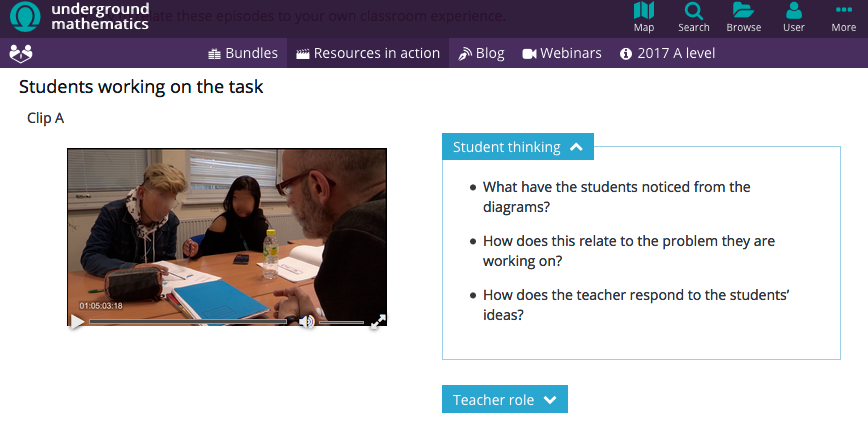 Watch at https://undergroundmathematics.org/calculus-trig-log/inverse-integrals-teacher-support (Clip A)
Watch at https://undergroundmathematics.org/calculus-trig-log/inverse-integrals-teacher-support (Clip A)
In the MECM project, the scientific practice of argumentation is broken down into four key components that are often challenging for students, and the videos show students’ thinking and difficulties related to each of the four components. This video (Figure 2) shows students working with various types of scientific evidence, including observations and measurements of the natural world.
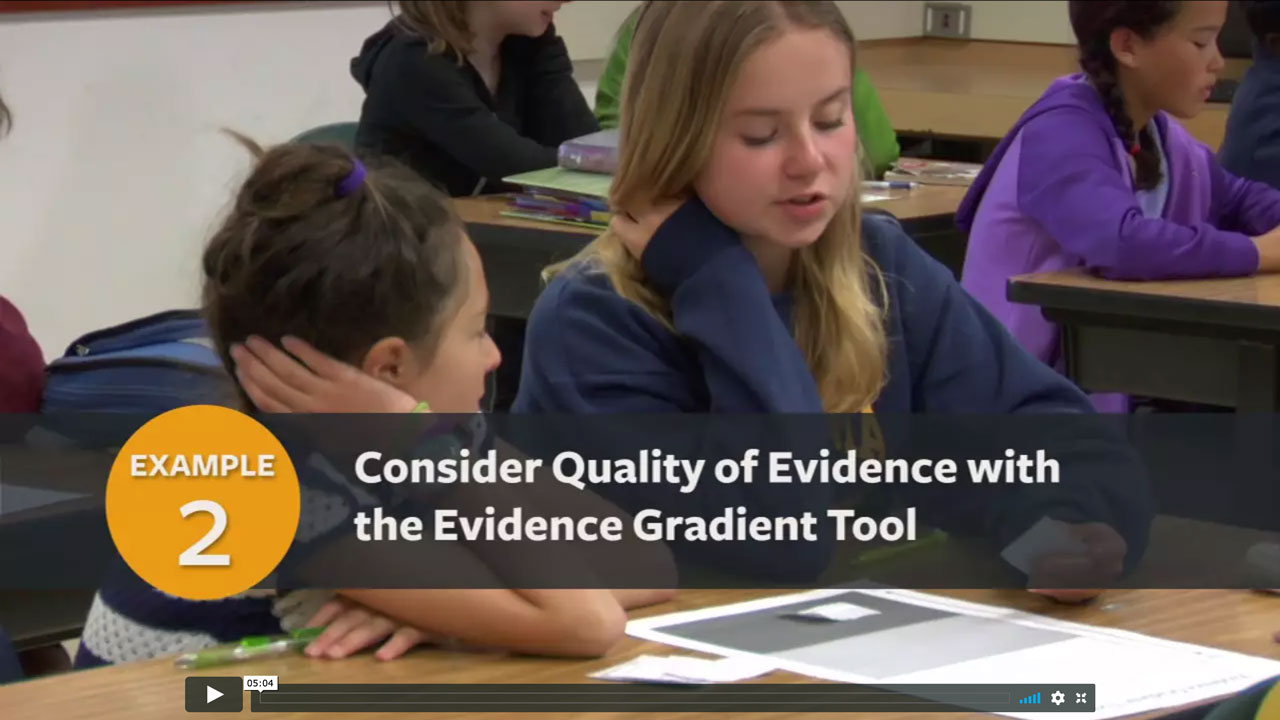 Watch at http://www.argumentationtoolkit.org/evidence.html (first video on page)
Watch at http://www.argumentationtoolkit.org/evidence.html (first video on page)
Organizing frames and viewing tasks provide visual and/or auditory guidance to notice details of students’ thinking
2The classroom videos in our projects are accompanied by organizing frames providing visual and/or auditory guidance to support teachers’ noticing. In the VRV project, an organizing frame is embedded into the software analysis tool. This frame is presented through two Views, each with a specific purpose and affordance. The Notice View is designed to help teachers become curious about students’ science ideas; the purpose is to focus on, observe objectively and gather evidence of learners’ ideas. In this View, the question, “What are the learners’ ideas?” appears as a graphic overlay on the video. Teachers also use a tag called ‘Idea Related to Goal’ to annotate students’ ideas related to a lesson’s learning goals. Thus, the learning objectives are emphasized to help teachers attend to pertinent student ideas (see Figure 3).
On the other hand, the Analyze View helps teachers shift to unpacking and making sense of students’ thinking (Sherin, 2007; van Es & Sherin, 2002). In this View, a different question appears on the video: “How are learners reasoning?” Teachers use a Science Lens with a set of color coded tags to examine students’ reasoning (see Figure 4). The Science Lens tags reflect scientific practices that are emphasized in current reform efforts in the U.S.A. but are often challenging for students. For example, the tags ‘Supports with Evidence’ and ‘Makes Sense of Data’ relate respectively to practices of evidence-based argumentation and analyzing and interpreting data (see National Research Council, 2012 ). In both Views, teachers can annotate students’ ideas in sticky notes that pop up when a tag is selected.
The HFP uses a very different organizing frame – that of the “cycle of collectively learning”, from the work of McDonald, Kazemi, and Kavanagh (2013). In this cycle, teachers move through four phases to learn a particular core practice. In the first phase, teachers are introduced to the practice (such as facilitating productive discussions) and the moves that support it. In the next phase, teachers rehearse the practice with their peers. This rehearsal includes getting feedback, which can be incorporated when using the same lesson with students. In the third phase, teachers record video of using the core practice with their students. Finally, in the fourth phase, teachers work with a coach and/or a group of peers to analyze the enactment of the core practice as captured in the video. When watching a video, the viewer can insert a comment directly on the timeline of the video right where they see the action or hear dialogue they want to note or question. In this project, phases one and two are implemented during the summer institute, while phases three and four are repeated multiple times during the following school year.
In the UM project, instructions for viewing tasks and written prompts are provided. These indicate that after viewing each clip, teachers should first mentally replay key moments in the clip, and compare their accounts if studying clips with colleagues. Teachers should then consider topic-specific and topic-generic prompts about students’ thinking that accompany the clip (additional details about task instructions are presented in Heuristic 3). For example for the videos accessed from the two-way functions page shown in Figure 5, topic-specific prompts ask teachers to consider which properties students in the video are trying to combine, and what the students are doing to find functions with these properties.
In the UM project, instructions for viewing tasks and written prompts are provided. These indicate that after viewing each clip, teachers should first mentally replay key moments in the clip, and compare their accounts if studying clips with colleagues. Teachers should then consider topic-specific and topic-generic prompts about students’ thinking that accompany the clip (additional details about task instructions are presented in Heuristic 3). For example for the videos accessed from the two-way functions page shown in Figure 5, topic-specific prompts ask teachers to consider which properties students in the video are trying to combine, and what the students are doing to find functions with these properties.
Elsewhere, topic-specific prompts ask teachers to consider what thinking (in this case about integration and functions) is revealed through the discussion, whereas topic-generic prompts ask how students are responding to each other’s ideas, and how their ideas relate to the problem they are working on. See, for example, Figure 6, relating to a video on integrals. The use of a specific prompt is intended to focus attention on the details in the clip and avoid evaluative responses in the first instance. The more generic prompts broaden the focus to noticing details of students’ mathematical behaviors or interactions.
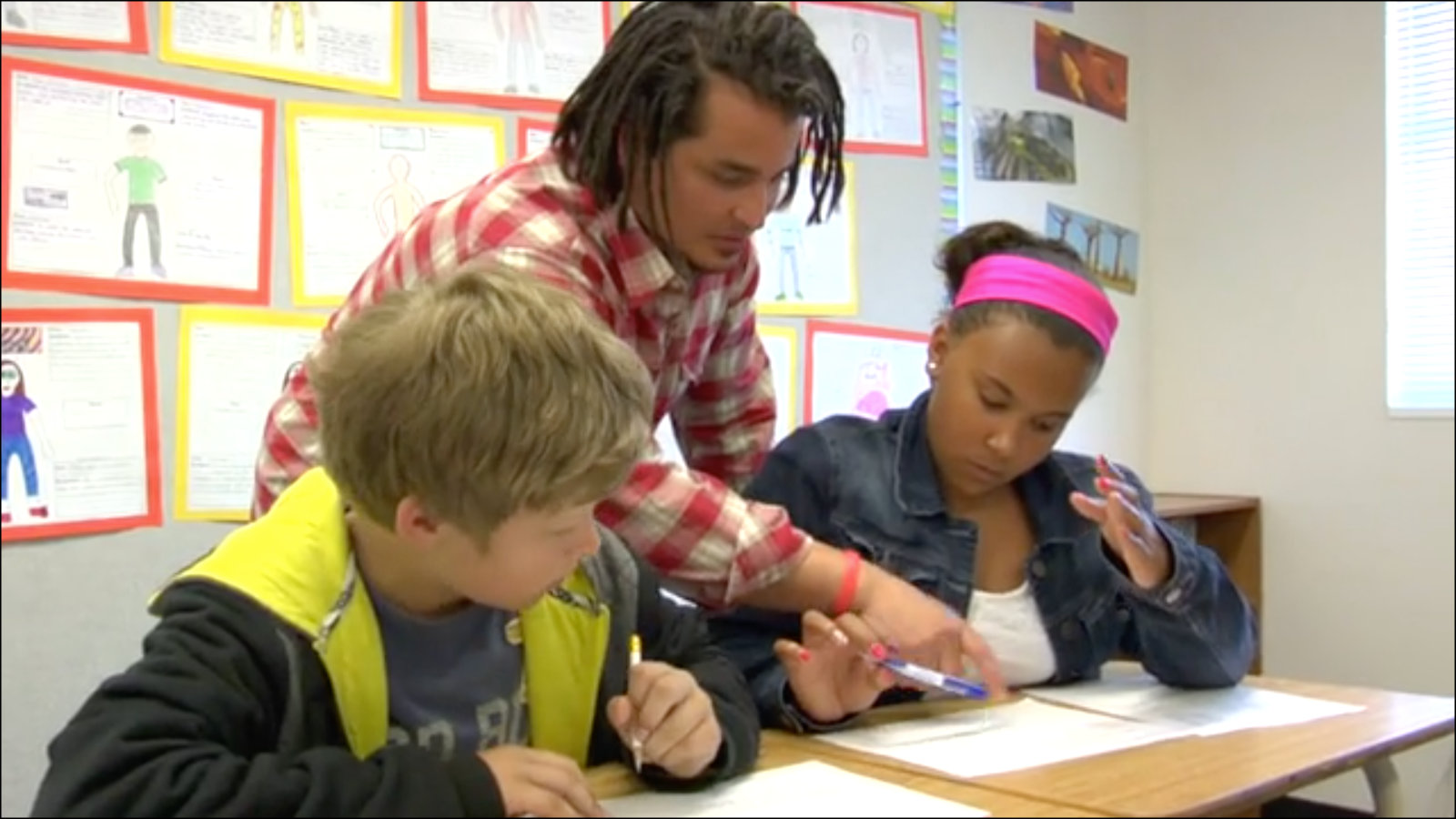 Watch at http://www.argumentationtoolkit.org/reasoning.html (second video on page)
Watch at http://www.argumentationtoolkit.org/reasoning.html (second video on page)
In the MECM project, graphic overlays and narrative voiceovers are used to support teachers in noticing students' thinking and overcoming difficulties in the key components of argumentation. Specifically, pop-up bubbles appear over the video as students are talking to make explicit the area of argumentation in the video. Additionally, narrative voiceovers from teachers and curriculum designers are captured in the videos, commenting on classroom interactions around the four challenging areas in argumentation. For example, in one lesson, students use for the first time what the designers refer to as the Reasoning Tool to explain why their evidence supports their claim. The accompanying video embedded in this lesson (Figure 7) introduces the tool, as well as the challenges that students can have in connecting evidence and claims. Then the video shows students using the Reasoning Tool to tackle this area of challenge in scientific argumentation. One curriculum designer explains,
“We found that it is very difficult for middle school students to make their reasoning clear - to articulate their reasoning. And we found the Reasoning Tool helps with this challenge, because it lays out for the students a structure that helps them see…”
To conclude, the two approaches reveal salient decision points to consider in supporting teachers’ noticing of students’ thinking and classroom interactions. A seemingly obvious yet pivotal design choice is the focus of the videos. If teachers are to attend to students’ ideas and reasoning and shift away from ’distractions’, then videos need to foreground students’ thinking and actions. This may be more challenging when teachers capture their own videos, as in the VRV and HFP projects, than when designers themselves generate classroom videos. Therefore, designers need to provide teachers with clear guidelines for what to foreground in recording their own classroom videos.
A second design choice lies in generating suitable organizing frames and viewing tasks to help teachers not only focus on students’ thinking, but to also analyze and make sense of it. The organizing frames and viewing tasks are particularly vital when teachers study videos of other teachers’ practices whom they may not know personally, as in the UM and MECM projects. In viewing unfamiliar classroom contexts, teachers may be more likely to focus on and evaluate the videotaped teachers’ personal dispositions, general pedagogy and classroom management, instead of attending to important details of students’ thinking. Furthermore, in developing frames with supports like electronic tags, questions, or prompts to organize teachers’ noticing, a key point is whether these supports should address generic aspects of students’ thinking and classroom interactions, or subject-matter-specific aspects. It is possible that a combination of general and specific supports may be appropriate to guide teachers’ noticing.
A related issue is the type of viewing task for teachers. The projects described here illustrate tasks like tagging and annotating particular events, and observing the videos silently and/or discussing with colleagues particular aspects of students’ thinking highlighted in the supports. Thus, these approaches and examples show that in designing video to support teachers’ noticing of students’ thinking and classroom interactions, key points of consideration are: the focus of the videos, the generality versus specificity of organizing frames, and the types of viewing tasks for teachers.
Heuristic 3
viEngaging in reflection allows teachers to make sense of their experiences and to then use this knowledge to inform future decisions (van Es & Sherin, 2008). Our third heuristic is focused on how video use and supports can encourage teachers to reflect on their own teaching in a way that informs pedagogical decision-making. Specifically, video designs aim to encourage teachers to make connections between student thinking and teacher actions and to consider the impact of teacher moves and strategies on students’ thinking. We will briefly review related literature and then describe how the four projects have designed video use and supports to encourage teachers to reflect on their practice.
Video has many benefits for helping teachers develop an inquiry stance to their work, particularly when teachers learn to interrogate the video in a systematic and intentional way. It can “capture much of the complexity of classroom interactions and allows teachers to re-view classroom episodes multiple times and from different perspectives” (van Es et al., 2014, p. 342).
In a review of the literature about the use of video to facilitate teacher reflection, Tripp and Rich (2012) found a variety of reflection tasks that teachers can engage in during video analysis (e.g., checklists, written reflections, direct editing of their videos, interviews or conferences). These tasks were valued for facilitating reflection by helping teachers to notice things they had “previously either disbelieved or ignored altogether” (Tripp & Rich, 2012, pp. 686-6811).
Zhang and colleagues found that teachers engaged in descriptive reflection (i.e., “noticing salient features in a classroom situation”) and critical reflection (i.e., “making a judgement about future action through careful deliberation”) when viewing video of their own teaching individually (p. 455). Conversely, they engaged in comparative reflection (i.e., “considering alternative views and different perspectives”) when discussing their video with peers (Zhang et al., 2011, p. 455). The same study used published video, video of peers’ classrooms, or teachers’ own video to facilitate teacher learning and found each to be of value, although teachers found video of their own teaching to be most useful. A key affordance of published video was that it enabled the researchers to model the form of analysis they wanted teachers to develop, but there were challenges associated with the relevance of content or grade level, as well as a lack of understanding of the teaching context. This raises again the importance of Heuristic 1, establishing close connections between video use and teachers’ daily practice.
Jaworski (1990) reports that viewing clips from lessons without the opportunity to discuss the context with the teacher may result in “a feeling of not being told enough about what occurred to really make sense of what has been seen” (p. 64). To overcome challenges in relating to published video, Zhang et al. (2011) recommend that content and grade level should be relevant, and that video should be accompanied by information about the context. Jaworski suggests, “A rule of watching video excerpts has to be that you know only what you see ... What is important is to distil general principles about teaching and learning from what has been seen” (1990, p. 64).
It is recognized that establishing norms for viewing video is critical and yet may be problematic (van Es & Sherin, 2008; Coles, 2013; Jaworski, 1990; Brophy, 2007). Reporting on using video with in-service mathematics teachers, Jaworski identifies “barriers to a constructive event” noting that, “Negative reactions often arise from seeing a teacher act differently to the way we, as teachers, would expect to act ourselves” (1990, p. 63). Coles (2013), and Borko, Jacobs, Seago, & Mangram (2014) identify decision points and practices for facilitating video-based discussions. Building on previous research on how to orchestrate productive discussions with video, van Es and colleagues (2014) propose a framework of four high-leverage practices for facilitating video-based discussion: (1) orienting the group to the video analysis task, (2) sustaining an inquiry stance, (3) maintaining a focus on the video and the mathematics, and (4) supporting group collaboration.
Facilitating teachers’ reflection on their practice through the use of video therefore presents a design challenge. We describe how the projects include reflection tasks to support viewing classroom video, either individually or in collaborative settings. This includes selecting video clips for sharing, annotating clips, protocols for viewing video individually or collectively, and prompts or questions for teachers. We first describe the two projects in which teachers view and share video of their own classrooms (HFP and VRV), and then the two which provide footage of other teachers’ classrooms (MECM and UM).
Teachers reflect on video of their own classrooms
1In both the HFP and the VRV project, teachers analyze, select and share video of their own classrooms in order to develop their practice in relation to specific professional learning goals. The process by which teachers select and share videos is designed to facilitate a process of reflection to impact teachers’ pedagogic choices.
In HFP, the coach, teacher, and peers tag video with questions and provide feedback. Fellows target an instructional practice, such as facilitating sense-making discussions, and one equity principle to focus their video collection. The choice of what to focus on is guided by the teachers’ experiences during the summer institute and supported by interactions with their coaches.
In the VRV project, software and paper-based supports are provided to help teachers prepare video cases for independent reflection and/or to discuss with colleagues in school-based Video Clubs. In the VRV software tool, teachers use a feature called Review Canvas to assemble video clips. Teachers are provided with examples of video cases explicating three key components of a well-designed case: the context, an organizing case question, and relevant video clips. The context comprises the lesson’s learning goals, overarching instructional question, and a description of the science investigation or activity that was video-recorded. Including the context in the video case helps teachers to reflect on teaching and learning in relation to their instructional goals and activities.
Teachers put forward an organizing question or dilemma for their case that focuses on students’ thinking related to the learning goals. Articulating questions about students’ thinking is a critical first step in guiding teachers to ultimately consider the impact of and implications for their teaching. Teachers are also asked to include brief video clips depicting relevant student thinking and classroom interactions. Additionally, teachers generate questions about next steps in teaching based on students’ thinking (see Figure 8).
To foster teachers’ reflection during collegial interactions, a written protocol provides a structure and associated guidelines for discussing classroom videos. The protocol emphasizes sharing questions or dilemmas about student thinking, encourages colleagues to analyze student thinking depicted in the video, and encourages the teacher sharing the case to reflect on implications for his/her own teaching.
Teachers reflect on video of other teachers’ classrooms
2Both MECM and UM use embedded or linked videos within web-based teacher support materials for specific lessons or tasks. Therefore, teachers are asked to view clips that have been identified for specific purposes by the project designers. Both projects use prompts and questions to support teachers to reflect on student thinking and to connect this with their own classroom practice.
The MECM project includes two features to support teacher reflection: interactive reflective prompts and video reflection questions. Interactive reflective prompts are embedded at the beginning of a number of lessons, to encourage teachers to reflect on their own instruction. These prompts are then linked to different resources depending on the teacher’s response. For example, in terms of confidence, when the teachers click on the first lesson in the Earth Science unit, they initially see the prompt shown in Figure 9. Depending on which choice the teacher selects, a different window then pops up with resource suggestions. For example, if a teacher selected “Not very confident, I would benefit from more support” they would be provided with the video illustrated in Figure 10.
In addition to prompts that support teachers to reflect on their own beliefs and knowledge, other prompts encourage teacher reflection on the classroom enactment of the argumentation lessons. The goal of these prompts is to reflect on the strengths and challenges of the instruction within the classroom, such as considering student difficulties. For example, after the first science seminar, the teacher is asked to reflect on the quality of the argumentation that took place. Depending on the teacher’s choice (Excellent, Good, Just okay, or Not good at all), the curriculum provides different suggestions or support in another window.
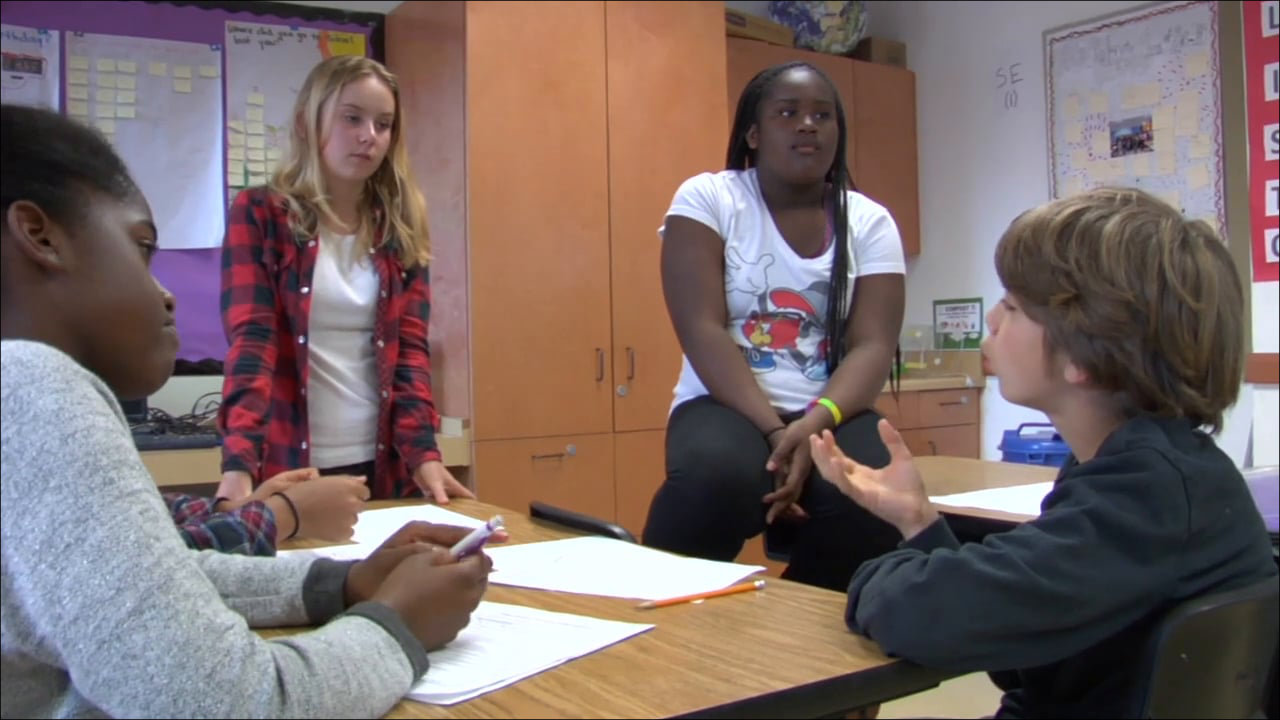 Watch at http://www.argumentationtoolkit.org/student-interaction.html (second video on page)
Watch at http://www.argumentationtoolkit.org/student-interaction.html (second video on page)
As noted above in the section on Heuristic 2, the UM site provides a protocol for watching and reflecting on the video before the videos. The protocol is intended to support descriptive and critical reflection (Zhang et al., 2011) and interpretive rather than evaluative responses (van Es & Sherin, 2008), whether teachers are viewing the clips alone or as part of a group. Videos are directly associated with a specific UM task, but the prompts and questions move teachers’ focus towards more general issues of mathematical thinking and classroom practice. Teachers are prompted to reflect first on mathematical content and then on relationships between students’ thinking and teacher actions, after which they are asked to consider what may have resulted if a teacher had or had not intervened. A teacher reflects,
“It was helpful to see the students following misconceptions and talking a lot about math. This made me consider when to step in and help them.”
To convey a fuller context, some UM video clips are accompanied by teacher and student interviews, which may also support comparative reflection for teachers watching the clips on their own. After watching video of teachers reflecting on a video clip, a teacher noted
“Reflecting on my own view of the videos was useful, but seeing other teachers discuss it was great in highlighting things I missed.”
Both MECM and UM explicitly encourage teachers to make connections with their own practice. In MECM, for one lesson in which students wrote a scientific argument, the Session Prep included a video called Strategy: Writing for a Hypothetical Audience (Figure 11). This discussed students considering a particular audience to make their written arguments more persuasive. The accompanying Video Reflection Question asks, “What argument writing strategies have been successful for you?” The goal of the question was to encourage teachers to think about strategies they had used in the past to better adapt the lesson to meet the needs of their students. Similarly, UM classroom video clips are followed by the question “As a teacher, what choices might you make in similar situations in your own classroom?”
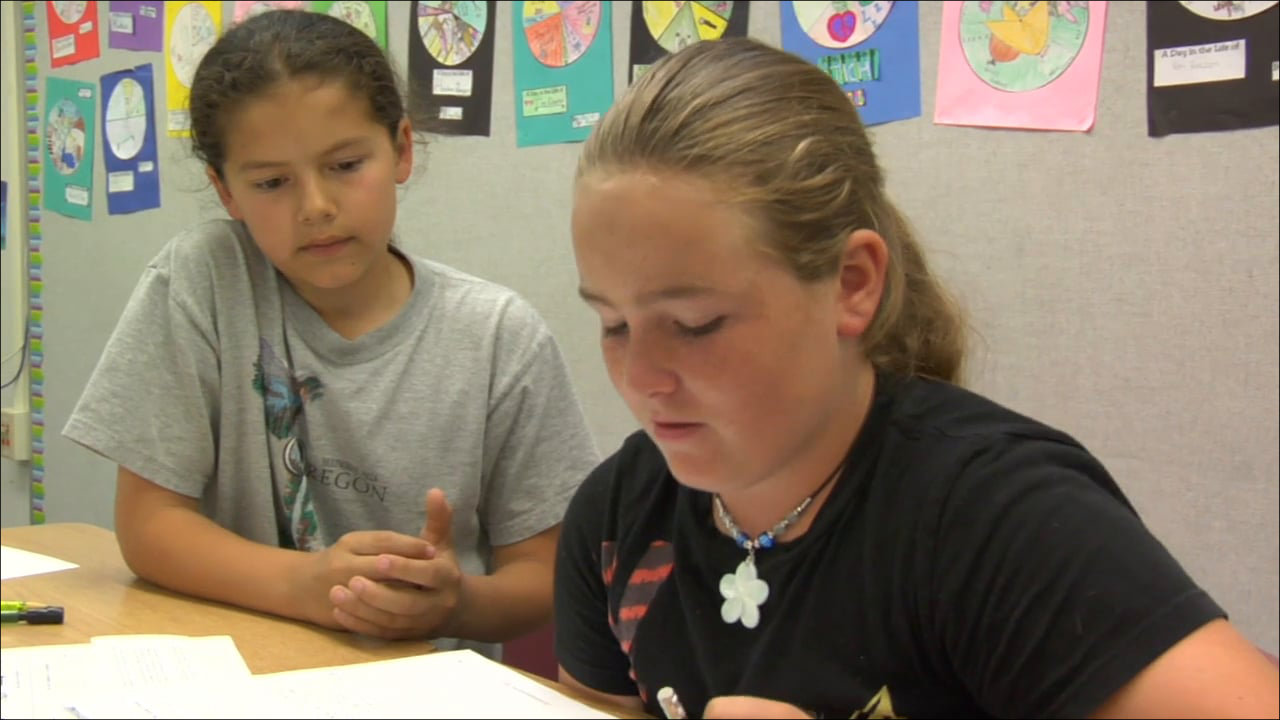 Watch at http://www.argumentationtoolkit.org/reasoning.html (last video on page)
Watch at http://www.argumentationtoolkit.org/reasoning.html (last video on page)
These examples illustrate how video use and supports can encourage teachers to reflect on their own teaching and make connections between student thinking and teachers’ actions. The projects use a range of supports - from low intensity options, such as written protocols and prompts that teachers can use when watching videos, to medium intensity of MECM where the choices that teachers make determine which video they see next, to the high intensity of the HFP instructional coach. The design choices for video supports in each project are guided by the type of video recorded, as well as the delivery mechanism for video use, yet each project is deliberate in its aims to connect teacher reflection to future pedagogical decision-making. These combinations of protocols, activities, and prompts support teachers to establish norms for viewing classroom video, encouraging interpretive rather than evaluative responses, and to focus reflection on specific aspects of teachers’ practice.
Conclusion
viiTeaching is about learning; therefore, identifying effective tools and strategies to support teachers in the pursuit of effective teaching is an important endeavor. As the four projects illustrated in this paper show, there are many ways to use video as a tool for teacher learning. An overview is given in Table 1. The devices and platforms available today are economical, easy to use, and work in contexts around the world. The literature base indicates that watching and reflecting on videos of classroom practice provides teachers with valuable opportunities for growth and offers strategies for teacher learning to occur in multiple ways. What is less evident in the literature, and was the intent of this paper, is the identification of practical design principles that can guide the use of current video-based tools the development of future platforms, and strategies for encouraging interactions among users.
|
Heuristic |
Questions to consider |
Empowering Teachers Through VideoReView (VRV) |
Underground Mathematics (UM) |
Multimedia Educative Curriculum Materials (MECM) |
Hollyhock Fellowship Program (HFP) |
|---|---|---|---|---|---|
|
1: Video should be situated in the daily practice of classroom teaching. |
|
Uses classroom friendly hardware and software to enable teachers to capture and study video of their own instruction. |
Uses video clips to show students’ unscripted first attempts at rich tasks and complex interactions. |
Educative videos are embedded within the preparation section of lessons in a web-based Teacher’s Guide. |
Teachers use an app on smart devices to collect classroom video of specific instructional practices. |
|
2: Video use and supports should facilitate teachers’ ability to notice student thinking and classroom interactions. |
|
Camera focuses on what students say and do. Teachers use electronic tags to annotate students’ ideas and reasoning related to learning goals. |
Written prompts support video clips encouraging teachers to examine students’ thinking and providing opportunities to consider multiple interpretations of students’ actions and ideas. |
Videos highlight key aspects of student thinking and classroom interactions, with supportive narration and graphic overlays. |
Teachers, peers, and instructional coaches review and electronically tag videos. Focus questions support teachers’ noticing evidence of student thinking. |
|
3: Video use and supports should encourage teachers to reflect on their own teaching, connect student thinking and teachers’ actions, and inform pedagogical decisions. |
|
Teachers meet in school-based, teacher-led ‘Video Clubs’ to share video cases of their own classrooms. Supports guide teachers to prepare cases prior to meetings and to analyze videos in the meetings. |
Videos show teachers how rich tasks may play out in classrooms. Prompts draw attention to the impact of teachers’ actions on students’ ideas. |
Videos in the preparation section included a reflection prompt focused on the teachers’ own practice. |
Teachers review and tag their video before meeting virtually with their instructional coach and/or content cluster. |
Design Heuristic 1: Video should be situated in the daily practice of classroom teaching
1All of the projects illustrated in this paper include the use of video situated in daily practice. There are two major branches of applying this heuristic -- situating the video content in the context of daily practice and situating the access to video in the context of teachers’ daily practice. In addition, two types of video are available to support professional development: video of the teacher’s own practice or video of other teachers’ practice. The advantage of studying one’s own practice is the immediacy of the work and the familiarity of the context. The advantage of studying someone else’s practice is the opportunity to observe a different way of doing something in the classroom that leads to student learning.
Design Heuristic 2: Video use and supports should facilitate teachers’ ability to notice student thinking and classroom interactions
2This heuristic implicitly focuses on the technical aspects of the use of video, because without the capacity to collect or access video easily, pause the video, add comments, or ask questions in relationship to key actions in the video, it would not be possible to further develop teachers’ abilities to notice what is happening. If we want teachers to notice what students are thinking and how they are communicating what they think, it is essential that we step out of the act of teaching in the moment. It is also essential that we not rely on individual’s memories of what happened. Video of classroom practice, which relates to questions and challenges that teachers have, is an invaluable resource for supporting teachers in developing the skill of noticing. A key aspect of supporting teachers’ ability to notice is to make instructional practices available for rigorous inquiry and analysis. This approach contributes to teachers’ ability to notice classroom interactions by allowing them to ’slow down’ teaching and learning processes and to focus on the analysis of student thinking.
Design Heuristic 3: Video use and supports should encourage teachers to reflect on their own teaching, connect student thinking and teachers’ actions, and inform pedagogical decisions
3This heuristic is closely connected to the previous heuristic, because without the ability to notice, teachers would have great difficulty reflecting on their own teaching. In Heuristic 3, we emphasize the nature of the supports that encourage reflection, as well as the way that video is used to inform decisions. Again, the intention of this heuristic is supported by the ability to ’slow down‘ time and watch and re-watch an act of teaching that has already occurred. Each of the projects described in this paper have worked to capture the richness and complexity of classroom practice in ways that encourage reflection, which can lead to stronger pedagogical decisions to support student learning.
Finally, we would be remiss if we did not note that having a video-based approach is a very important component of improving teaching, but it is not sufficient to create change. It is also essential that teachers be afforded the professional time, space, and trust to engage in the systematic analysis and discussion of videos. This structured time coupled with video-based tools focused on high-quality instruction can contribute to change both what teachers notice and how they interpret these events leading them to change their instructional practices.
Acknowledgements
viiiThanks to Katherine L. McNeill for her substantial contributions to the discussions that led to this paper, as well as to Frans van Galen for feedback on an early draft.
The Empowering Teachers Through VideoReView (VRV) project is supported by a grant (#1415898) from the National Science Foundation.
The MECM project was supported by the National Science Foundation under the grant DRL-1119584.
Underground Mathematics was developed by the University of Cambridge and funded by a grant from the UK Department for Education. Underground Mathematics Resources in Action were produced in collaboration with Dr Steven Watson at the University of Cambridge Faculty of Education.
The Hollyhock Fellowship Program is supported by a generous gift from an anonymous donor.
References
ixRoth, K., Wilson, C., Taylor, J., Hvidsten, C., Stennett, B., Wickler, N., Kowalski, S., Numendahl, P., & Bintz, J. (2015). Testing the Consensus Model of Effective PD: Analysis of Practice and the PD Research Terrain. Paper presented at the National Association of Research in Science Teaching (NARST), Chicago, IL.
About the Authors
x
Anushree Bopardikar is an educational researcher at TERC, Massachusetts. Her research interests lie in designing curriculum, and video-supported teacher professional development programs. On the Empowering Teachers Through VideoReView project, she contributes as both developer and researcher, working closely with collaborating teachers to facilitate their participation and learning during the program, and assisting in the design and implementation of the associated research.

Janet Carlson is an Associate Professor (Research) and the Director of the Center to Support Excellence in Teaching (CSET) at Stanford University. The work of the center is focused on developing a portfolio of research, design, and development activities that improve instruction and develop leading teachers who positively impact the learning of all students. Carlson’s work in the center includes designing and leading the research agenda for the Hollyhock Fellowship, a two-year transformative professional development (PD) program focused on early career teachers from high-needs schools. This research examines the links between the design of the PD and changes in core teacher practices and changes in student learning.

Elizabeth Kimber is an education resource designer for Underground Mathematics in the Department of Pure Mathematics Mathematical Statistics at the University of Cambridge, UK. She has taught mathematics in schools and at undergraduate level and has worked on curriculum projects for the Nuffield Foundation. Her research interests involve task design and the development of teacher support materials, including classroom video.

Suzanna Loper is Curriculum Director for the Learning Design Group at the Lawrence Hall of Science, University of California, Berkeley. She works with the team of curriculum developers and researchers that created the Hall’s newest K-8 curriculum program, Amplify Science. Prior to joining the Hall she was a high school and middle school science teacher.
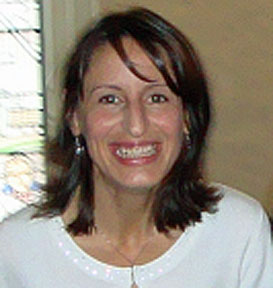
Natalie Pareja Roblin is a postdoctoral researcher at the University of Pittsburgh (USA), and a visiting researcher at Ghent University (Belgium). She has contributed to various projects concerned with curriculum design, technology integration, research-practice partnerships, and teacher professional development. Her main research interest is to understand and enhance the links between educational research and practice.

Tatiana Rostovtseva is a researcher at the University of Cambridge, UK. She leads on the Evaluation strand for the Underground Mathematics Project. Tatiana has worked in classrooms, government ministries, non-profits, and research projects in seven countries across four continents. Her research currently investigates the role of classroom dialogue in evaluating innovative curricular materials in the UK. Her research interests also focus on expanding equity in education.
